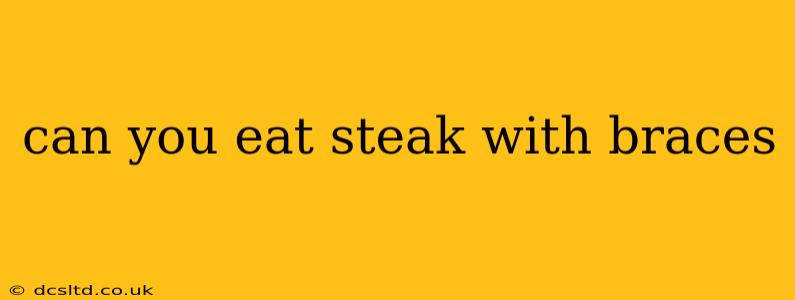Having braces doesn't mean you have to say goodbye to your favorite foods forever! But some require extra caution, and steak is definitely one of them. This guide will explore the complexities of eating steak with braces, addressing common concerns and offering practical advice.
What are the Risks of Eating Steak with Braces?
The primary risk of eating steak with braces lies in its toughness and tendency to get stuck. Steak fibers can easily become entangled in your brackets and wires, potentially causing:
- Broken Brackets: The pressure of chewing tough steak can snap a bracket loose from your tooth. This requires a visit to your orthodontist for repair, delaying your treatment.
- Bent Wires: Similarly, the force can bend or break the wires that hold your teeth in place. This can cause discomfort and disrupt the alignment process.
- Loose Brackets: Even if not broken, brackets can become loosened, potentially leading to discomfort and shifting teeth.
- Food Trapped in Braces: Small pieces of steak can get wedged between your teeth and braces, leading to discomfort and potentially increasing the risk of cavities.
How to Safely Eat Steak with Braces
While steak isn't completely off-limits, it's crucial to take precautions:
- Cut it into very small pieces: This drastically reduces the chewing force needed and minimizes the risk of damage to your braces. Think bite-sized pieces, almost like you're feeding a toddler.
- Cook it thoroughly: Well-done steak is significantly easier to chew than rare or medium-rare, reducing the strain on your braces.
- Chew slowly and carefully: Avoid rushing your meal. Pay close attention to each bite, ensuring that you're not putting excessive pressure on your braces.
- Use a sharp knife: A sharp knife helps you cut the steak into manageable pieces more easily, reducing the strain on your jaw and braces.
- Consider the cut: Tender cuts of steak, like filet mignon, are easier to manage with braces than tougher cuts like ribeye or chuck roast.
What if a Bracket Breaks or a Wire Bends?
If you experience a broken bracket, bent wire, or significant discomfort while eating steak (or any food), contact your orthodontist immediately. Don't try to fix it yourself; attempting to do so could cause further damage.
Can I Eat Other Tough Foods with Braces?
Steak isn't the only tough food to watch out for. Other foods that require similar caution include:
- Tough meats: Similar to steak, tough meats like chicken with the bone, or very chewy meats should be avoided until your braces are removed.
- Hard candies: These can easily break brackets.
- Popcorn: Small kernels can get stuck in your braces and cause problems.
- Nuts: The shells can break your braces, and the nuts themselves are very tough.
- Ice: Avoid crunching on ice, as this is extremely hard on your braces.
Always prioritize your oral health and consult with your orthodontist if you have any concerns about specific foods and your braces.
What are some alternatives to steak while I have braces?
There are plenty of delicious alternatives to steak that are braces-friendly. Consider softer meats such as well-cooked chicken, fish, or ground beef. You could also opt for vegetarian options like pasta, well-cooked vegetables, or lentils.
How long will it take to heal a broken bracket?
The time it takes to repair a broken bracket will depend on the extent of the damage and your orthodontist's schedule. It's typically a relatively quick procedure, but it's important to get it fixed promptly to prevent further issues.
This information is for general knowledge and does not constitute medical advice. Always consult with your orthodontist or dentist for personalized guidance regarding your specific situation and dietary needs while wearing braces.
